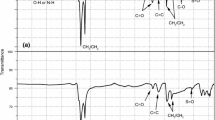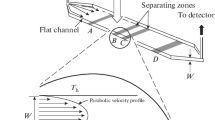Abstract
Asphaltenes, the heaviest and most polar fraction of crude oil, are responsible for the clogging of oil pipelines and of underground reservoir rocks. Asphaltenes are defined as a solubility class (toluene- or benzene-soluble, n-alkane insoluble), and a consensus is still lacking on the molar mass (M) averages, distribution, and range of these materials. Size-exclusion chromatography (SEC) is among the most widely employed methods for characterizing the M averages and distributions of both natural and synthetic polymers and, as such, has seen widespread application in the study of asphaltenes. SEC analysis of asphaltenes presents a number of challenges, however, some inherent to all low-M materials and some unique to these particular analytes. Here, we have experimentally compared several of the most commonly used approaches to SEC of asphaltenes, in hope of both demonstrating the influence of experimental conditions upon the results obtained as well as to determine optimal conditions of analysis. In the end, while the former goal was met, the latter one remains an open challenge in the field.






Similar content being viewed by others
References
ASTM (2005) ASTM Method D 6560–00. Annual Book of American Society for Testing Materials Standards. ASTM, Philadelphia
Arnauld CN (2009) C&EN 87(38):12–17
Sheu EY (2002) Energy Fuels 16(1):74–82
Herod AA, Bartle KD, Kandiyoti R (2007) Energy Fuels 21(4):2176–2203
Mullins OC, Martínez-Haya B, Marshall AG (2008) Energy Fuels 22(3):1765–1773
Marshall AG, Rodgers RP (2008) Proc Nat Acad Sci 105(47):18090–18905
Mullins OC, Sheu EY, Hammami A, Marshall AG (eds) (2010) Asphaltenes, heavy oil, and petroleomics. Springer, New York
Moore JC (1964) J Polym Sci A 2:835–843
Striegel AM, Yau WW, Kirkland JJ, Bly DD (2009) Modern size-exclusion liquid chromatography, 2nd edn. Wiley, Hoboken
Striegel AM (ed) (2005) Multiple detection in size-exclusion chromatography. ACS Symp Ser 893, American Chemical Society, Washington, DC
Striegel AM (2008) Anal Bioanal Chem 390:303–305
Striegel AM (2005) Anal Chem 77(5):104A–113A
Striegel AM (2013) In: Fanali S, Haddad PR, Poole CF, Schoenmakers PJ, Lloyd D (eds) Liquid chromatography: fundamentals and instrumentation. Elsevier, Amsterdam, pp 193–223
Altgelt KH (1965) Makromol Chem 88:75–89
Stout CA, Nicksic SW (1971) In: Altgelt KH, Segal L (eds) Gel permeation chromatography. Marcel Dekker, New York
Bunger JW, Li NC (eds) (1981) Chemistry of asphaltenes, Adv Chem Ser 195. American Chemical Society, Washington
Andreatta G, Bostrom N, Mullins OC (2005) Langmuir 21(7):2728–2736
Behrouzi M, Luckham PF (2008) Energy Fuels 22(3):1792–1798
Haidar Ahmad IA, Striegel AM (2010) Anal Bioanal Chem 396:1589–1598
Striegel AM, Alward DB (2002) J Liq Chromatogr Rel Technol 25(13–15):2003–2022. See erratum in Striegel AM, Alward DB (2003) J Liq Chromatogr Rel Technol 26(1):157–158, in which there is a typo: The value of [η] w for PE 282 in TCB at 135°C should be +0.0036 dL g−1
Striegel AM (2004) J Chromatogr A 1033:241–245
Richard DJ, Striegel AM (2010) J Chromatogr A 1217:7131–7137
Gray MJ, Dennis GR, Slonecker PJ, Shalliker RA (2005) J Chromatogr A 1073:3–9
Higgins RS, Klinger SA (eds) (1990) Solvent guide, 3rd edn. Burdick & Jackson, Muskegon
Striegel AM, Brewer AK (2012) Annu Rev Anal Chem 5:15–34
Acknowledgments
The authors would like to acknowledge Prof. Alan G. Marshall and Dr. Ryan P. Rodgers for helpful advice and discussions. Commercial products are identified to specify adequately the experimental procedure. Such identification does not imply endorsement or recommendation by the National Institute of Standards and Technology, nor does it imply that the materials identified are necessarily the best available for the purpose.
Author information
Authors and Affiliations
Corresponding author
Rights and permissions
About this article
Cite this article
Dong, S., Striegel, A.M. Size-Exclusion Chromatography of Asphaltenes: An Experimental Comparison of Commonly Used Approaches. Chromatographia 76, 725–733 (2013). https://doi.org/10.1007/s10337-013-2472-0
Received:
Revised:
Accepted:
Published:
Issue Date:
DOI: https://doi.org/10.1007/s10337-013-2472-0




